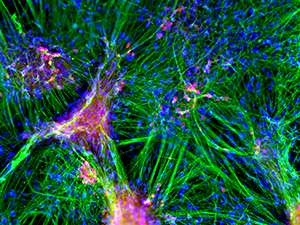RNA and protein molecules join forces to switch on gene networks responsible for brain development

Long noncoding RNAs (lncRNAs) are one of many RNA subtypes that do not give rise to protein but instead modulate the expression of other genes. Scientists are particularly interested in lncRNAs owing to their prominent role in regulating how embryonic stem cells give rise to mature tissues. Lawrence Stanton and colleagues at the A*STAR Genome Institute of Singapore have now demonstrated how one lncRNA's collaboration with a protein partner helps to steer development of the brain.
Stanton and his co-workers had previously identified the rhabdomyosarcoma 2-associated transcript (RMST) lncRNA in a search for lncRNAs that are specifically expressed during neuronal maturation. "We selected RMST for detailed analysis because we could demonstrate that it is a key regulator of neurogenesis," explains Stanton. RMST levels rise sharply as neuronal maturation proceeds (see image). The researchers demonstrated that they could block neuronal development in precursor cells by depleting this lncRNA.
To determine its mechanism, Stanton and co-workers isolated RMST from cells in a manner that allowed them to co-purify proteins that were physically associated with the RNA. These experiments revealed a strong, specific interaction with SOX2, a transcription factor protein that binds specific DNA sequences within the genome to switch nearby genes on or off. "It was quite exciting for us to find that RMST is a partner for SOX2, which has already been established as a key regulator of neurogenesis," says Stanton.
The researchers identified an extensive set of genes whose activity was altered in a similar fashion by reducing levels of either SOX2 or RMST in neuronal precursors, providing further evidence for a collaborative functional relationship. Importantly, many genes within this subset have well-defined roles in the control of neuronal development. In the absence of RMST, SOX2 was no longer physically associated with many of these genes, indicating that the lncRNA helps to target the transcription factor to this subset of genes. Closer examination revealed that rather than binding directly to DNA, RMST appears to recruit SOX2 via interactions with the chromatin proteins that provide infrastructure for the chromosomal DNA adjacent to these genes.
"This [finding] expands our understanding of the regulatory process that controls the birth of neurons," says Stanton. He notes that the study builds on a growing body of work indicating a potential role for brain-specific lncRNAs in certain neurological disorders. His team is now exploring the possibility that abnormal regulation of RMST or other lncRNAs might contribute to the neurodegenerative pathology of Parkinson's disease.
More information: Ng, S.-Y., Bogu, G. K., Soh, B. S. & Stanton, L. W. "The long noncoding RNA RMST interacts with SOX2 to regulate neurogenesis." Molecular Cell 51, 349–359 (2013). dx.doi.org/10.1016/j.molcel.2013.07.017
Ng, S.-Y., Johnson, R. & Stanton, L. W. "Human long non-coding RNAs promote pluripotency and neuronal differentiation by association with chromatin modifiers and transcription factors." The EMBO Journal 31, 522–533 (2012). dx.doi.org/10.1038/emboj.2011.459



















